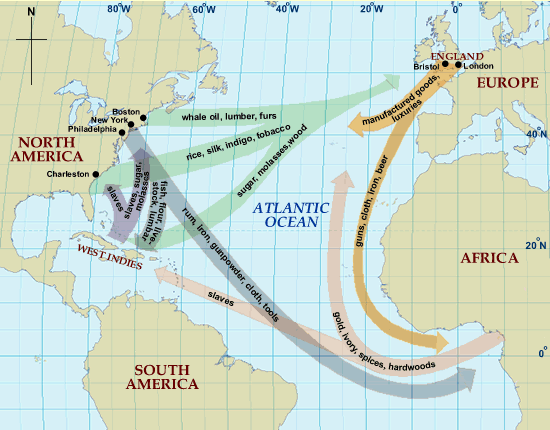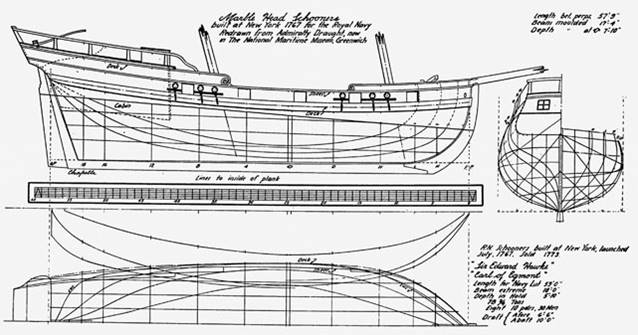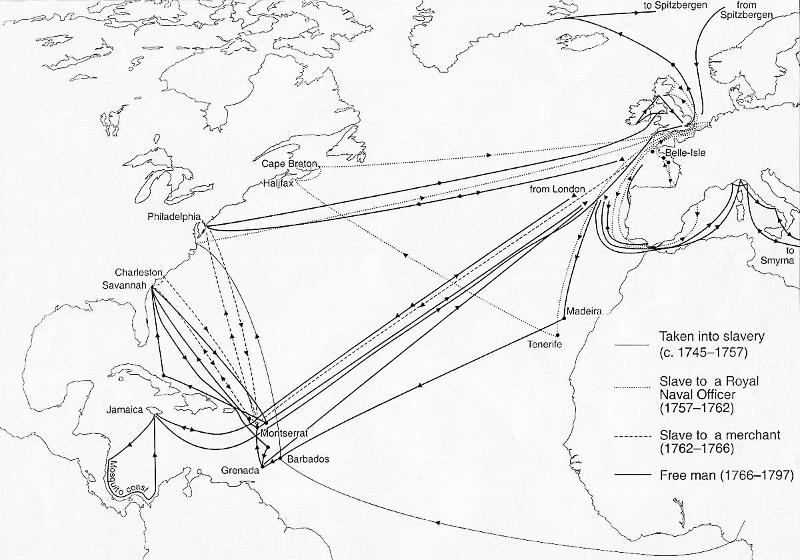
Voices of Labor in the Atlantic World
An Interactive Tour of Servitude, Commerce, and Travel in the 1600s and 1700s
In 1609, a Virginia Company investor explained why this privately funded expedition to America seemed so timely and potentially profitable at the time; it drew upon the ambition and desperation of growing numbers of English people who faced diminishing livelihoods at home. By that time, most of the public fields and forests of England had been privatized by nobles and industrial businesses, but Robert Gray recalled the era when
"commons of our Country lay free and open for all Common[er]s to [e]njoy,
for there was room enough in the land for every man… that in those days
we had no great need to follow strange reports, or to seek wild adventures…"
(The Many-Headed Hydra, 20)
By the mid-1500s, landowners started expelling tenant farmers and fencing most of the nation's formerly common land as part of the private estates. This economic shift set much of the newly landless population adrift, seeking other farms where they could settle or wage work in the cities, the army, or the sea. This population drift was essential to the growth of British colonies in North America as English ships transported thousands of Europeans, Africans, and Native Americans across the Atlantic in the 1600s and 1700s. Some of these passengers relocated voluntarily; most were forced abroad due to enslavement, criminal punishment, or legal proscriptions for education.
This activity introduces you to individuals who worked as part of the British labor system that eventually dominated the Atlantic trade in the colonial era. These case studies complicate the narrative of American colonial history as a search for religious freedom. Specifically, you will get to know more about people who were transported unwillingly to various parts of North America for someone else's economic and political gain. By learning about them, you will also practice analyzing primary and secondary historical sources related to the following major HIST 1301 key terms:
- Trans-Atlantic slave trade
- middle passage
- indentured servitude
- Virginia Company
- triangular trade
-cash crops/ staple crops
- mercantilism
- Bacon's Rebellion
- epidemics
The growth of the European colonies in North America depended on the removal of millions of people. Most of these people were relocated by force to perform the tedious work that made American settlements and plantations possible. Historical records tend to overlook these slaves and indentured servants, focusing on the households of businesses that they worked for. In the grand scheme of international trade, forced laborers were treated like products rather than individuals.
So the best way to find out more about slaves and indentured servants in the colonial era is to review business records -- specifically the inventories of trans-Atlantic ships. Choose the name of one laborer from each of the following websites, and read some basic facts about them.
Option 1: Slave Voyages: The Trans-Atlantic Slave Trade Database
Option 2: Virtual Jamestown Indentured Servants Database
Now use the facts about these two laborers to make broader guesses about the other slaves and indentured servants in early America:

Slavery and indentured servitude were isolating experiences. Relatively few of those who were caught up in these labor systems gained the time or the means to write about their experiences. Yet the following four individuals produced memoirs and letters that give us insight into the lives of laborers in the 1600s and 1700s. Click each name to read biographical details, skim two excerpts, and then write a short comparison of them.
|
|
Henry Spelman, a 14 year old traded by Capt. John Smith to the Powhatans
|
Excerpt from "Relation of Virginia, 1613"
|
|
|
Elizabeth Sprigs, a teenager whose father sent her to Maryland on an indentured contract
|
Letter to Mr. John Sprigs (her father), 1756 |
|
|
Olaudah Equiano, a Nigerian man who was sold into the English slave trade at a young age and became an abolitionist after freeing himself
|
Excerpt from The Interesting Narrative of Olaudah Equiano, or Gustavas Vassa, 1789 |
|
|
John Jarrett, a leader of the Maroons, a militant community of escaped Africans who were expelled from Jamaica to Nova Scotia and Sierra Leone
|
The Second Maroon Petition, May 10th, 1796 (from Nova Scotia and the Fighting Maroons: A Documentary History) |
Now that you know more about two of these individuals, use this space to compare a few details about their lives: 
A person's property was an essential aspect of trade relationships in trans-Atlantic travel. Slave traders stripped their captives of any belongings and clothing when they were forced onto ships. The lack of privacy and mementos added emotional hardship to the physical crises these enslaved people faced.
Migrants from Europe were more likely to have packed some belongings in advance, but they could end up in indentured servitude if the value of their cash and belongings did not cover the expenses of their transportation. Unexpected costs like medical care for sick relatives depleted the travelers' savings to the point that many could not pay the full price of their ship fare upon arrival in America. To compensate the shipping company, indebted travelers and their children signed contracts like this:

The indenture contracts formed a partnership between the traveller and the "master" to exchange years of service for a promise of future compensation like acres of land, livestock, clothing, and room and board during the time of service. Click the image to take a closer look at the terms of this contract between servant Patrick Larkin and master Thomas Blood. Review each man's responsibilities to decide if this seems like a fair contract:

There are also several important questions you could ask about each man's responsibilities, including what specific duties will be required during Patrick Larkin's sevice and how many provisions will be provided by Thomas Blood. The generalities of this type of contract made it likely that the master would maximize his profit by requiring too much work in return for too few resources.
The trans-Atlantic slave trade and the demand for indentured servants sustained the financial interests of six major European empires by the mid-eighteenth century: Spain, Portugal, France, Britain, Denmark, and the Netherlands. Each empire competed to acquire enough valuable goods to strengthen its treasury, and geographic expansion helped imperial soldiers gain access to more valuable resources. International competition hinged on the concept of "mercantilism," the theory that only a certain amount of wealth existed in the world; the discovery of mines and fertile land in other countries helped ensure that one empire could grow more powerful than another. Read this short article from the Trans-Atlantic Slave Trade Database to see how the trade in plantation-grown cash crops influenced the African slave trade and the empires that maintained it.
As mentioned in the article, the economic and political interests of the major European empires shifted dramatically by the 1750s. In particular, British officials tried to regulate the trade between North America, the West Indies, West Africa, and England to produce maximum profit for 'the mother country.' American colonial leaders also got more involved in the trade process as the settlements expanded.
When Henry Spelman arrived in 1609, the Virginia colony was at constant risk of disappearing due to famine, disease, and conflict with the Powhatan Indians. The colony stabilized in the 1620s thanks to the development of tobacco plantations and the influx of laborers who made the plantations flourish. After Bacon's Rebellion in 1676, the Virginia plantation owners invested more of their profits into purchasing African slaves rather than hiring more indentured servants. The price of enslaved labor remained higher than the price of an indentured servant, which was one reason why most American colonial traders tried to cut expenses by purchasing supplies and manufactured goods at the cheapest rates. This trend was problematic for Britain because its mercantile system depended on a triangular trade pattern that sold slaves from West Africa, cash crops and lumber from North America, and manufactured goods from English factories.

The British government established a Board of Trade in 1696 to regulate these trade patterns with laws that required American colonists stop purchasing manufactured goods and luxuries from any traders who were outside of England. Nevertheless, a representative from the Virginia colony reported three years later that many of his fellow colonists continued the illegal luxury trade with pirates and non-English traders. Consider how his words linked illegal trade and slavery with England's diminishing political control in America.
"By this means People so what seems good in their eyes, and are in a fair way of shaking off their dependence upon England.
Nay to break all the laws made to kirb them by the authority of King and Parliament, is a virtual throwing of their Dependence....These governments, as they are now ordered, do greatly encourage offences of every kind in the more useful Plantations. They entice Servants to run away from their Masters, in the neighbor Colonys, by refusing to give them up to their right owners, by which they both deprive the master of the Servants that run away, and spoil those that stay behind to the great Discouragement of Industry."
-- William Byrd II, "Representation of Mr. Byrd concerning Proprietary Governments," 1699
Answer these two questions to review Byrd's argument: 
The Atlantic crossing between ports in Europe or West Africa and North America was a distance of at least 3,700 miles. Most travelers took the voyage in large wooden schooner ships, built in New England colonies like Massachusetts and designed with a large holding area below decks.

Imagine what it may have been like to travel in this type of ship. The voyage typically lasted one to two months, though it could be extended by unfavorable weather, wind patterns, or occasional attacks at sea. A person's experience on board varied based on his or her status. Slaves and indentured servants were usually forced to stay below decks for most of the voyage, but only slaves were chained to the walls and floor of the hold as if they were packaged goods. Lying down on unfinished lumber for a month or more caused enslaved people to develop life-threatening problems like skin infections, sores, diarrhea, vomiting, and loss of mobility. Even without the chains, many voluntary European migrants died en route due to epidemics like cholera that spead on board. For a fictional account of how shipboard illness could force an English family into indentured servitude, see this excerpt of the novel Bound by Sally Gunning.
Historical novels help us imagine the perspective of a person traveling in the Atlantic World, and it is also see how a person's specific travels fit into the geography of their era. For example, consider this map showing all of the places where Olaudah Equiano travelled in his lifetime. Click the map for a larger version.

If you compare Equiano's travels with the triangular trade map from Step 4, you'll notice a similar pattern in both diagrams. Even before reading all of the details of his life, you can tell that Equiano's experiences as a Nigerian captive, a slave, a merchant sailor, and a leader of the British abolitionist movement kept him linked closely to mercantile trade patterns. Choose one of the other individuals featured in Step 2 and see what other conclusions you can draw about a traveler's life based on his or her destinations. Read that individual's biographical facts to figure out where they were from, what part of America they were living in at the time, and if that person's later travels are known. Then estimate where those places were located on this interactive historical map from the School Atlas of World History. Be sure to use the timeline at the bottom to set the map to the year 1750.
The school atlas map shows the basic outline of the continents, and the insets include the political boundaries for different eras. But national borders are not the only significant details that could be featured on a map. Try finding the same locations on the following historical maps to see how these places could be represented differently.
The Stevens-Brown Map/Orbis Typus Universalis, 1507-1513
Planisphere Physique, by Philippe Buache, 1757
Major Regions for Disembarkation of African Slaves, 1514-1866
Wind and Ocean Current Patterns, 1514-1866
Physikalischer Atlas (one of the first global disease maps), by Heinrich Berghaus, 1852
Each historical map compared locations based on a different theme, such as explorers' findings, important slave ports, weather conditions, and places where mosquito borne diseases were common. Such details were just as influential as imperial politics for the lifestyles (and death risks) of the people who lived there. For example, since schooner ships relied on wind to push the sails, the busiest ports were located in areas where the wind currents tended to blow towards the coast. Also, the Berghaus map indicates that people in West Africa and Brazil faced increased risk of "elephantiasis," a mosquito-borne disease that could cause disfigurement and liver damage. Like malaria and yellow fever, this disease became an epidemic in the Atlantic coastal regions of the West Indies and North America as infected mosquitoes spread it from people with previous exposure (West Africans). Consider this risk and other geographic factors as you rethink what you've learned about a specific Atlantic traveler. Finally, use the space below to write a thesis statement suggesting how the environment and geography of that person's destination may have complicated their experiences.

Now that you have written an argument about a specific historical figure from the seventeenth or eighteenth century and reviewed several details about Atlantic World trade, you are better prepared to answer midterm exam questions about the development of the British empire up to the American Revolution. The primary sources in this activity will also provide excellent evidence for an essay assignment or extra credit opportunities. You can explain the impact of British trans-Atlantic trade using a personal vignette, a comparison with a different perspective, general trends, political economics, historical fiction, and geography. The variety of these types of sources can help you craft a well-developed analysis of labor in the Atlantic World in the 1600s and 1700s.
For further information, see these suggested resources:
Websites
Slave Voyages: The Trans-Atlantic Slave Trade Database -- http://www.slavevoyages.org
Virtual Jamestown, Seventeenth Century Labor Contracts -- http://www.virtualjamestown.org/servantcontracts.html
Gilder Lehrman Institute of American History, Essays on the Origins of Slavery -- http://www.gilderlehrman.org/history-by-era/colonization-and-settlement-1585-1763/origins-slavery/essays
Books
Berlin, Ira. Many Thousands Gone: The First Two Centuries of Slavery in North America. Cambridge, MA: Harvard University Press, 1998.
Calloway, Colin. New Worlds for All: Indians, Europeans, and the Remaking of Early America, 2d ed. Baltimore: Johns Hopkins University Press, 2013.
Campbell, Mavis C. Back to Africa: George Ross and the Maroons: From Nova Scotia to Sierra Leone. Trenton: Africa World Press, Inc., 1993.
Campbell, Mavis C, ed. Nova Scotia and the Fighting Maroons: A Documentary History. Williamsburg, VA: Department of Anthropology, College of William and Mary, 1990.
Equiano, Olaudah. The Interesting Narrative and Other Writings: Revised Edition. Edited by Vincent Carretta. New York: Penguin, 2003.
Harms, Robert. The Diligent: A Voyage Through the Worlds of the Slave Trade. New York: Basic Books, 2002.
Jordan, Don and Michael Walsh. White Cargo: The Forgotten History of Britain's White Slaves in America. New York: NYU Press, 2008.
Linebaugh, Peter and Marcus Rediker. The Many-Headed Hydra: the Hidden History of the Revolutionary Atlantic. New York: Verso, 2012.
Morgan, Philip. Slave Counterpoint: Black Culture in the Eighteenth-Century Chesapeake & Lowcountry. Chapel Hill: University of North Carolina Press, 1998.
Richter, Daniel. Facing East from Indian Country: A Native History of Early America . Cambridge: Harvard University Press, 2001.